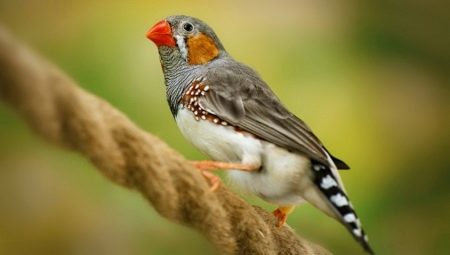For the older generation, poultry for keeping in an apartment is limited to several types of parrots and canaries, however, today the variety of pets can be much more impressive. Among overseas pichugs, amadins are notably popular, which today can be found in almost every pet store.
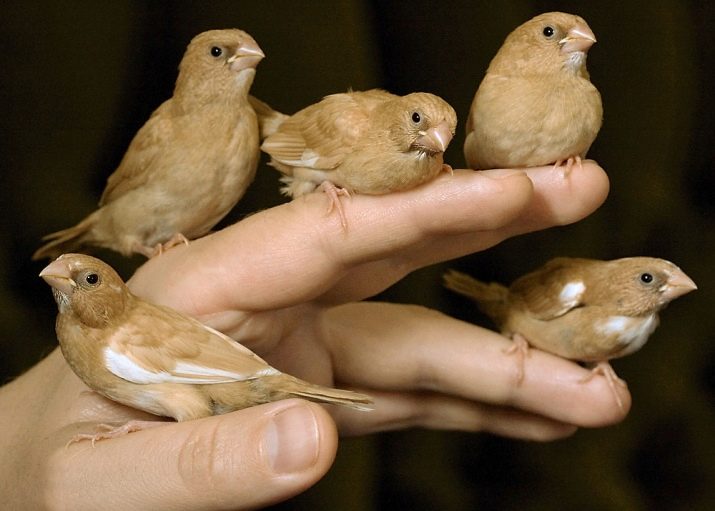
Description
Amadins in terms of biological classification belong to the family of finch weavers, consisting of more than three dozen species of birds. In the wild, they originally lived in the extreme south-east of Asia - in Indonesia and East Timor, also this is an original Australian species. Thanks to human efforts, this pichuga is much more widespread today - now it can be found in the wild in Puerto Rico, the USA and even in Europe - in Portugal.
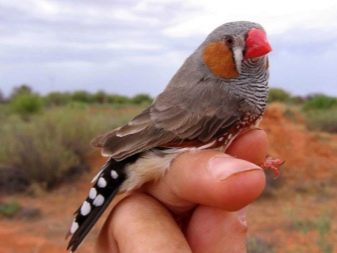
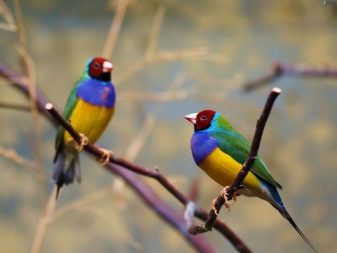
To understand why this particular bird is in demand among pet lovers, it’s enough to briefly walk through its features.
- Firstly, Amadinas are quite beautiful - they are not as colorful and bright as most parrots, which does not detract from their attractiveness.
- Secondly, such a pet does not require any outstanding conditions of detention and does not need complicated care, and even normally reacts to living in captivity, not showing anything that he is uncomfortable.
- Thirdly, a cute tropical bird is highly fertile, which simplifies its breeding and makes these birdies one of the least expensive on the market.
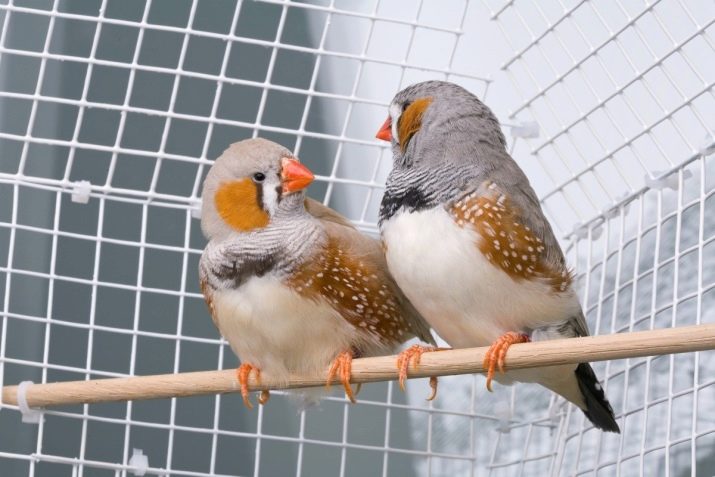
Since we are talking about the beauty of Amadins, it is worth to find out how they look.Unlike many other birds, in this species, the visual differences between males and females are not so obvious, but in general, the variety of shades of plumage is impressive - these birds are white, and brown, and fawn, and brighter colors like green, yellow, blue, red and purple. Males of Amadinas of many varieties specially "dress up" for the mating season, attracting ladies with bright plumage, although the rest of the year they look more simple.
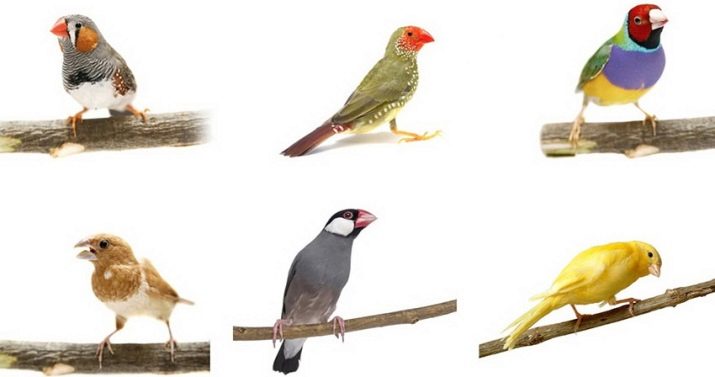
Amadin is often called beak-billed due to the fact that their beak has a special shine, as if it were made of wax. In most cases, it has a catchy red or orange color, adding beauty to the bird if its plumage is not distinguished by its colorfulness.
How to sing?
Many poultry at one time were chosen for a pleasant voice, but the amadina, frankly, does not apply to sweet-voiced singers. At the same time, she has a voice, and to someone such a pet may even seem quite noisy.
The assortment of sounds made by a typical Amadina is very diverse., and, apparently, expresses various emotions of a feathered pet. Twitter is present in the arsenal, and it is quite pleasant, but can be diluted with a loud whistle, which lovers of silence will not like. Sounds like hissing, buzzing and even a peculiar grunt are also characteristic of pichuga and atypical for most birds.
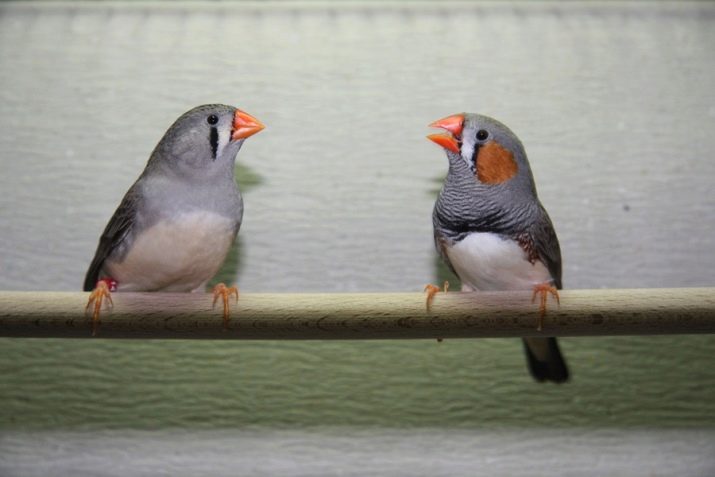
Kinds
All kinds of finch weavers can be called globally amadins, which means that more than 30 species of such creatures are offered to the lover of domestic animals. In fairness, not all of them can be found in pet stores, and some are even rare in the wild. All this biological diversity differs from each other mainly in the color of plumage and nothing more.

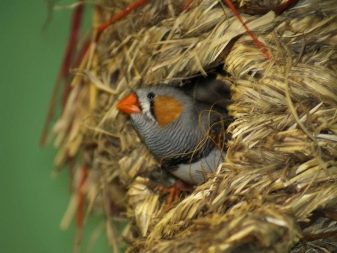
Most species got their name either because of the distribution area in the wild, or because of the specifics of their appearance.
Especially common as pets are only two species.
- Zebra Amadina also known as finch zebra. This species is by far the most common. He got his name for the characteristic "zebra" color, which is found only on the chest of the pichuga. Otherwise, such a bird looks quite similar to an ordinary sparrow - not for nothing because they are distant relatives. In most cases, all descriptions regarding homemade madadins are based on this particular species of pichuga. These birds differ in considerable noise, while they do not like neighbors of other species and do not get along with them.
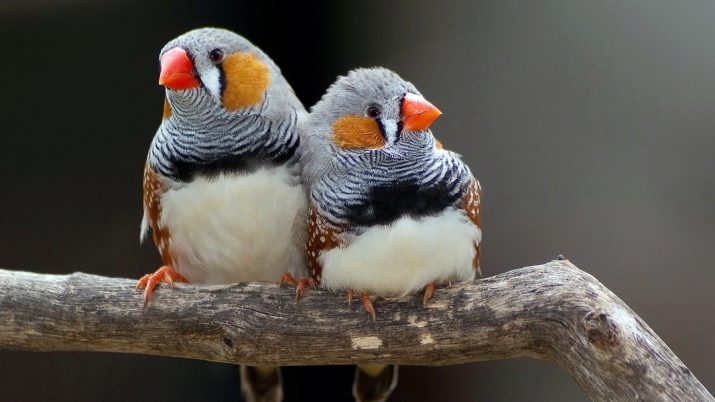
- Japanese Amadina This pet is unusual in that in the wild it is not found at all - it is the result of human breeding activity. In Europe, the bird came several centuries ago and since the XVIII century has become a fairly popular pet. Such a pichuga does not shine with bright plumage - it is sustained in brown-white tones, and even its beak is not red, but bluish-black. This pet is relatively quiet, its content is also appropriate if you do not need the regular appearance of new chicks - the females of this hybrid are completely barren, but not devoid of maternal instinct and can feed young animals of other species.
As for the males, they are often crossed with related species in order to achieve an improvement in the basic characteristics.
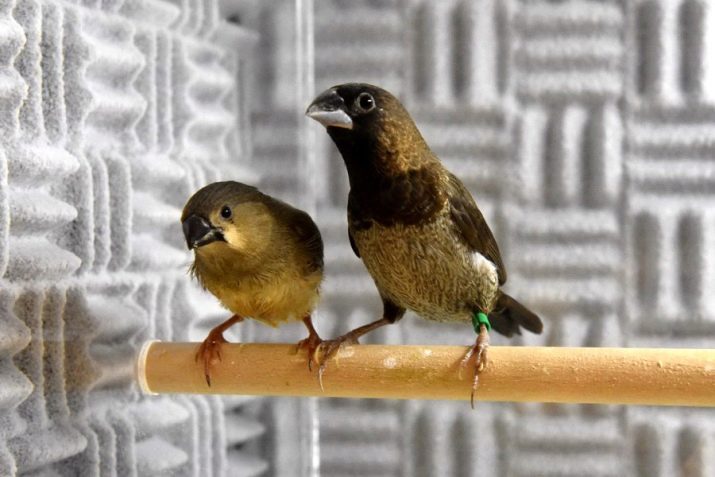
All other Amadins are found at home much less often, and therefore can be considered a matter of pride for their owner. Malabar and nutmeg Amadin, red-necked and pointed-toed, diamond, scaly and red-headed ones should be classified as relatively common species.
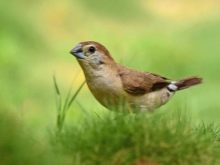
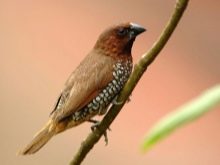

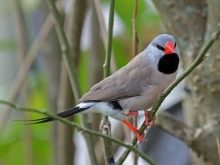

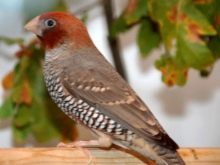
Colors
If you are chasing after truly colorful and bright birds, the Amadins are likely to be not the best choice for you, greatly inferior to the budgies in this component.If we talk about the widespread Japanese Amadina, it does not stand out in an interesting color at all - it is characterized by typical passerine colors, a black-beaked bird, accidentally met on the street, is not even perceived as a fugitive from the cage.
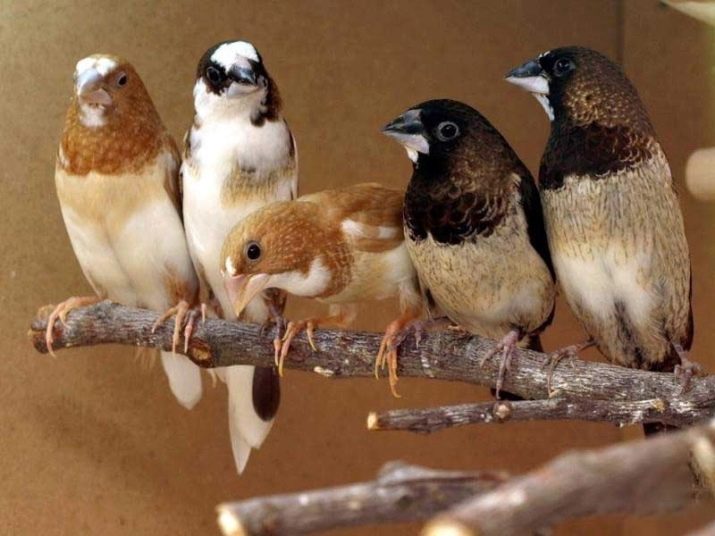
With the zebra amadina, which is rightfully considered the most popular, the situation is somewhat more interesting. With a common coloring in all the same colors, it has a characteristic pattern on the body, and even stands out with a clearly visible red-orange beak. In its plumage, other, brighter shades are possible, but it cannot be said that the bird is brightly painted and can be considered an example of saturated colors.
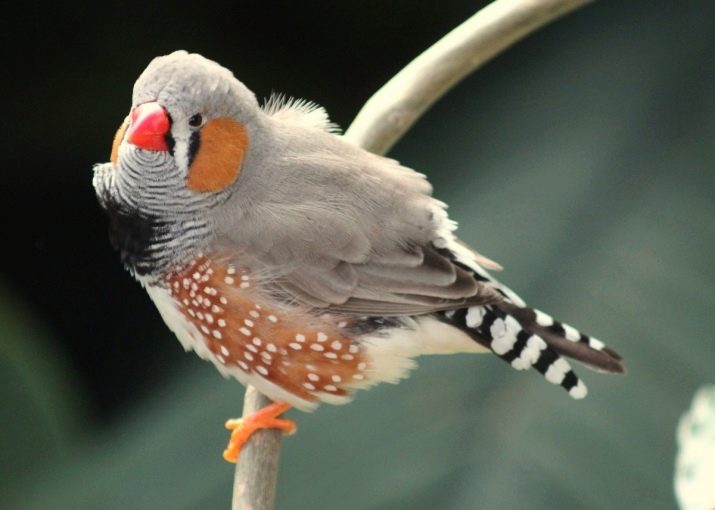
We mentioned above that, in general, plumage of almost any color, including attractive bright ones, can be characteristic of amadins. This is true, but then, apparently, it is worthwhile to search for rarer species of such pichuga. In many cases, the name of the amadina is named according to its coloring, and given that there are more than 30 species of these little birds, with a great desire, you can always find a colorful pet that matches your ideas about bird beauty.
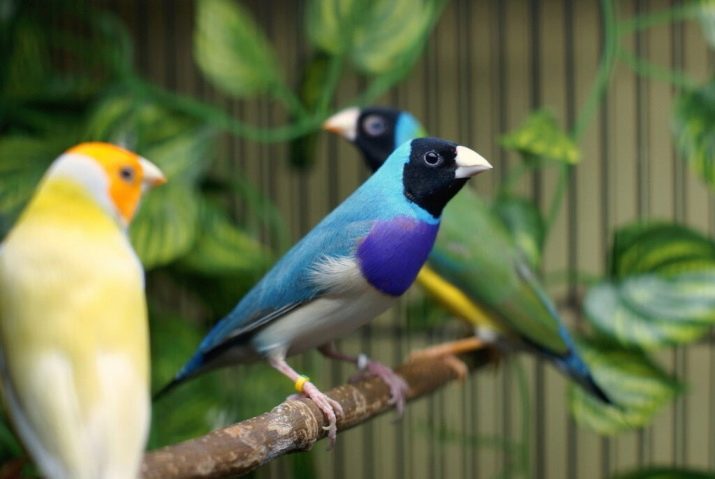
Growing conditions
Amadins are fairly considered some of the least whimsical poultrybut still they need certain living conditions, at least in the form of a correctly selected cell. Experts draw attention to the fact that it should not be round, like parrots - the fact is that due to the lack of angles, the pet becomes confused, he cannot understand which way to move, and because of this, he panics.
Besides, the size of the dwelling for pichugs must be sufficient to frolic - such a bird is notable for its remarkable mobility, and therefore, half a meter in all basic parameters (length, width, height) is a minimum.
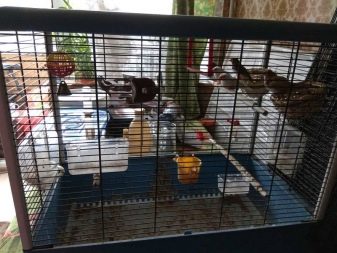
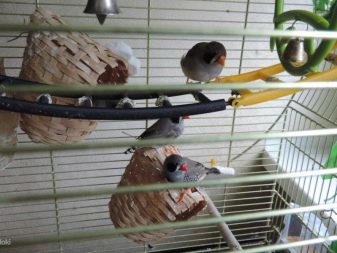
As for the material, it can be any of those on the market, but preference should still be given to the metal bars of the cage.
Despite the equatorial origin, Amadins do not like heat - the effect is that they in the original lived in the shadow of thick trees. The optimum temperature for them is about 20 degrees Celsius, so you have to look for a cool place in the apartment, choosing it so that the coolness is not caused by an ordinary draft. The humidity level should also ideally be stable - at 60–70%. The nest of pichugs should not be located on the floor - it is advisable to position the bottom of the cage 50 centimeters from it. The floor should be strewn with a layer of sand.
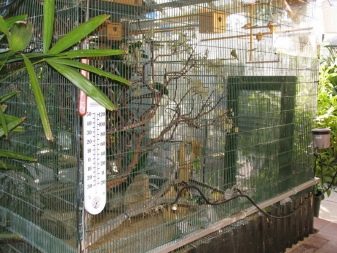

Sun exposure is good for amadins, but only in relatively small quantities - a maximum of 2-3 hours a day. If the cage installed in your home is large and cannot be moved, it means that you will almost certainly have to close it from the sun the rest of the time, otherwise an undesirable temperature increase cannot be avoided.
Amadin is usually not kept alone - they love a company of their own kind. If you feed the feathered brotherhood with different feeds, make sure that each type of feed has its own feeder. For stability, such an accessory should have a wall height of 2.5 cm or more, it is usually installed between the vents.
A convenient gated drinking bowl with constant access to fresh water is also needed. There is no rain at home, but in the wild, Amadins would appreciate rainfall, so bird breeding experts advise once a week, arrange this feathered bathing with a sprayer and water at room temperature.
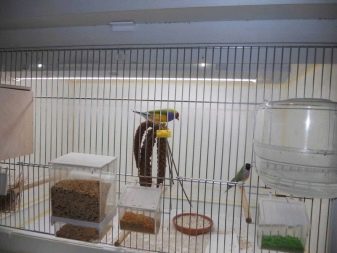
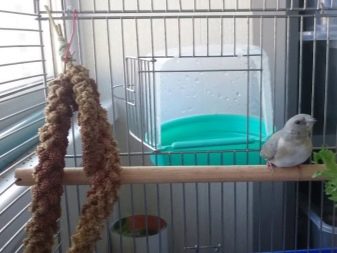
It will be even more useful for birds to install special bathing suits with a water level of about 2 centimeters, and it is advisable to use the liquid not even boiled, but settled.
Since in nature, amadins live in dense tropical forests with an abundance of branches and foliage, decorative swings and perches will matter not only from an aesthetic, but also from a practical point of view.By the same logic, artificial houses will be in demand, which will successfully replace the pichugs of tree hollows and delight the eyes of the owners and their guests.
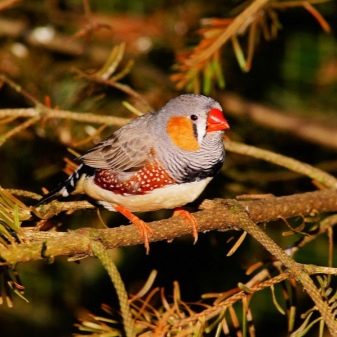
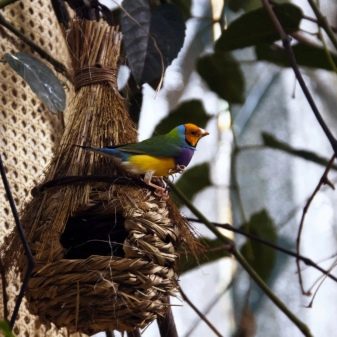
note that this pichuga is one of the shy ones, so you need to be careful with it: avoid loud noises and sudden movements, carefully bring in new people, do not turn off or turn on the bright light too sharply. All these situations plunge the amadine into a panic, they begin to hysterically rush around the cage, and, given their fragility, this can end very badly for pets.
For the same reason no other pets with predatory habits should be allowed to enter the room where the birds are kept - although they cannot penetrate the cage, the attempted attacks themselves will bring the birds to a pulp.

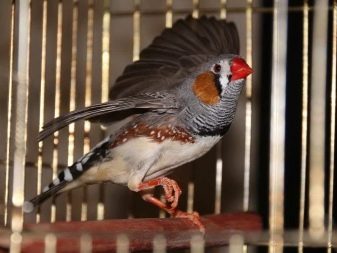
Experts also remind that smoking near the cage with amadins adversely affects the health of pets. Carbon monoxide also carries a big negative.
Proper care
One of the main responsibilities of the owner of Amadin is to maintain cleanliness in the cell. For this reason, potential owners of such pets are advised to choose cells of the simplest design possible - this usually helps to simplify the task and cope with it without too much effort. Routine cleaning involves washing all surfaces inside the cage with hot water or even scalding them with boiling water. Once a week it is advisable to change the sand in the pan.
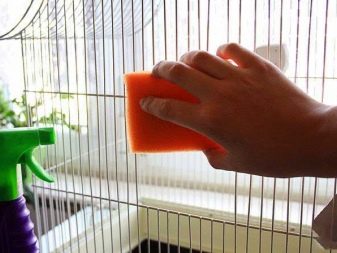

When breeding amadine at home, it is desirable to have not only the main, but also a spare cell. Only in this way you will be able to fully clean up the bird's house, especially since once a month you need to carry out not just cleaning, but a whole disinfection of the cell - ignoring this requirement, you risk creating a hotbed of parasites, among which there are different types of ticks. Carrying out disinfection involves first cleaning according to the method described above, and then additional washing with a special solution followed by rinsing.
Suitable as disinfectants 2% solution of carbolic acid or chloramine in the same concentration, disinsectal is also in demand, but in all cases, you should carefully read the instructions and follow the recommended precautions when working with these substances. Effective means are also considered chamomile in the form of a powder or feverfew - they are simply poured onto a pallet, covered with a sheet of plain paper and then with a layer of sand.
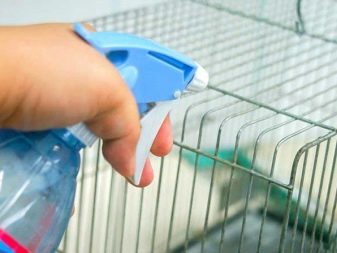

The owner, striving to care for his pets in accordance with all the rules, should acquire a certain set of tools:
- a scoop is needed to dispense sand in the cage and remove old dirt;
- a set of brushes and brushes will make it possible to make disinfectant solutions even reach hard to reach crevices;
- rubber bulb for the same purpose;
- scraper to wipe away stubborn and hardened dirt.
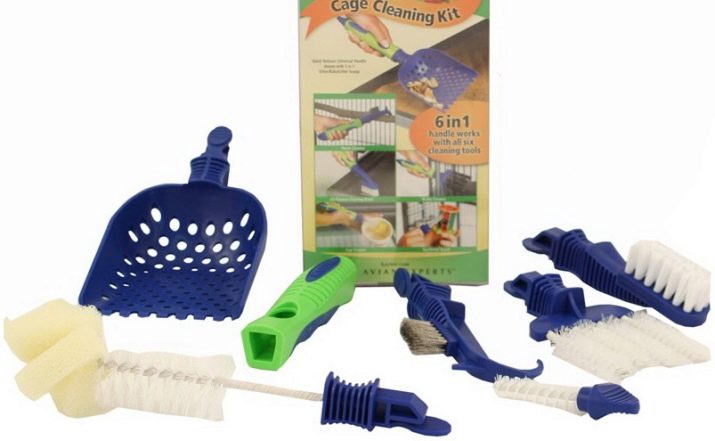
Drinking bowls and bathers tend to darken over time - microscopic algae settle on their walls, which is also not very good. Fighting them is easier than you might think - all you need is to add coarse-grained salt or millet to the tank, add half the water and shake it well when closed. After that, the container is rinsed once again with clean water, and it immediately acquires its original form.
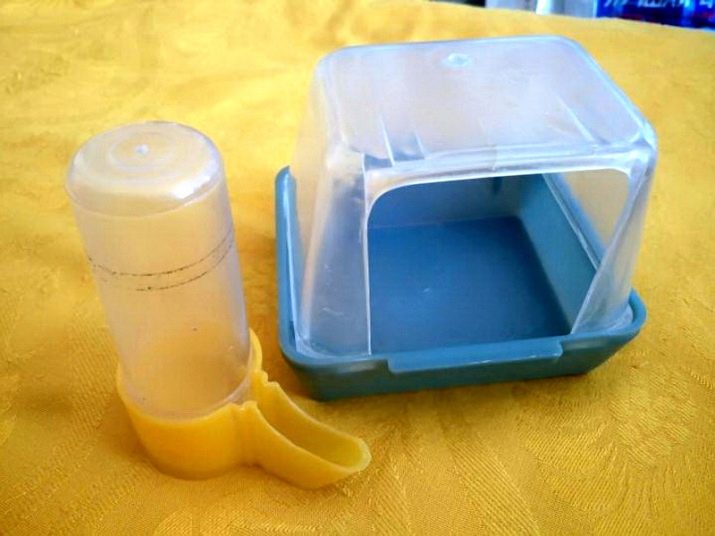
What and how to feed?
The main food for homemade amadins is a grain mixture that you can not buy in stores, but cook it yourself. It should contain 6–8 components, but millet is the basis: for 1 kilogram of such grain, you should take 300 grams of canary seed, 150 grams of oatmeal in the form of cereals, 100 grams of salad, hemp, rape and mohair, as well as 50 grams flaxseeds and another 20 - seeds of any other herbs growing in the meadow.
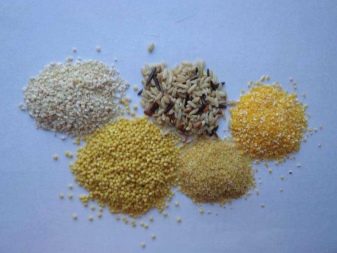
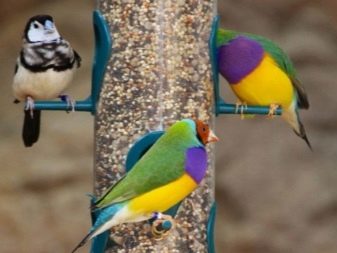
Amadins do not belong to voracious birds: each pichu should be given only one teaspoon of such a mixture per day, and the dosage calculation is greatly simplified by the fact that feeding is carried out only once a day. At the same time, a careful owner should include in the diet of feathered and more valuable vitamin supplements of natural origin - for example, sliced bananas or crushed dandelions. You can give other fruits with berries, as well as vegetables and herbs.
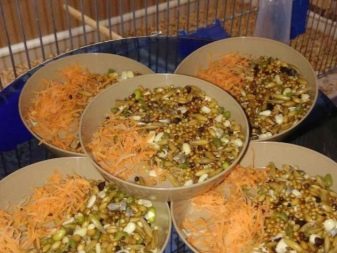
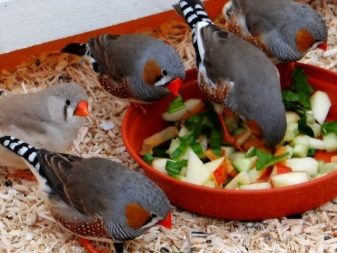
If you didn’t have any of the cereals described above, you can add any other porridge to the menu.
As befits most birds, Amadina feeds not only on plant foods - she also does not refuse live food. During the breeding season, it is literally necessary for these pichugs, so the owner should think about how to periodically treat his pets with bloodworms and other similar feeds.
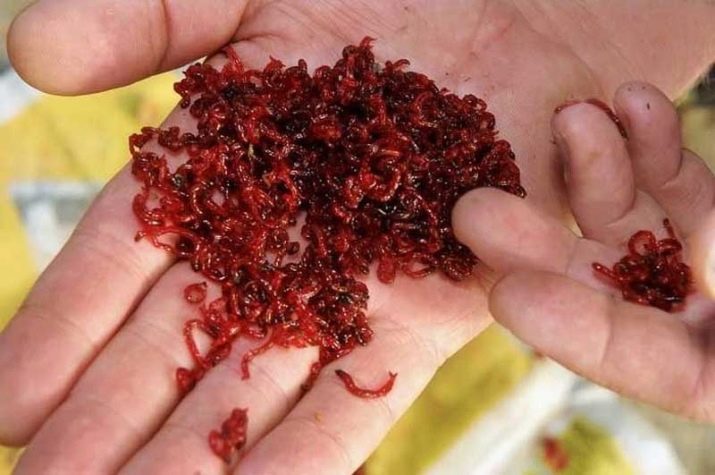
In winter, amadins, as well as the people that breed them, may experience a certain lack of vitamins and minerals, so experts advise including germinated cereals in their diet. Cottage cheese and steeply boiled eggs will also not be superfluous in the daily menu of home weavers.
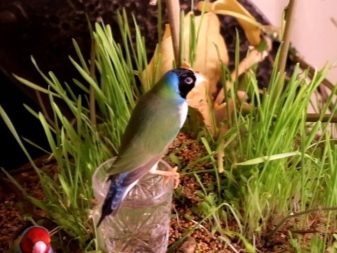
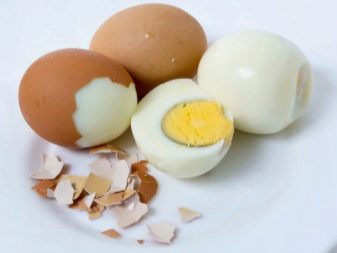
In addition, Amadins, like any other birds, need mineral fertilizing, without which, in particular, there cannot be eggs with a sufficiently strong shell. For these purposes, even ordinary sand is suitable, which is already present in the cell, but for a change you can also give shell rock or crushed egg shells.

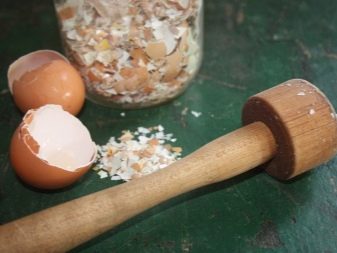
Taming
Amadina is considered a tame bird - you can even pick it up if you are previously accustomed to it. Initially, the bird is rather shy, so when approaching the cage for any purpose, you should avoid sudden movements and loud sounds. If everything is done correctly, over time the bird will get used to the fact that you do not pose a danger to it - then you can even pick it up in your hands to stroke it.
It is possible to understand whether the amadina is ready for close contact with the owner by its behavior. Suspecting that you are a danger, the pichuga will not sing - this is how it tries to be invisible without attracting the attention of a potential predator. If the pet is tweeting, then you are no longer a threat to him, although you still need to be careful with him.
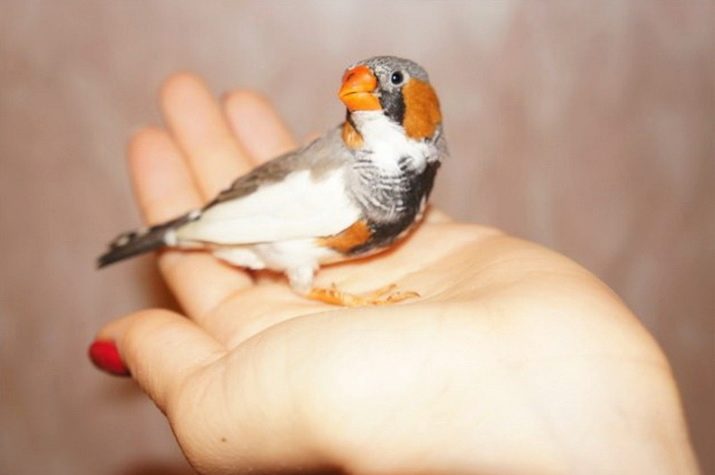
We repeat that the singing of this pet can hardly be called sweet-voiced, but for the owner it can be a pleasant signal that the amadina does not feel any discomfort.
Breeding
One of the main reasons for the crazy popularity of Amadins is the simplicity of their breeding at home - thanks to this, each owner can try himself as a breeder and achieve success, even without any special experience and capabilities.
Amadina puberty occurs approximately in 2-3 months, but you should not immediately require continuation of offspring from pichugs. On the contrary, it is better to postpone it until the age of 5-6 months, otherwise laying the eggs will be a difficult test for the female, and the result may be her insufficient weight gain and the removal of frail, unviable offspring.
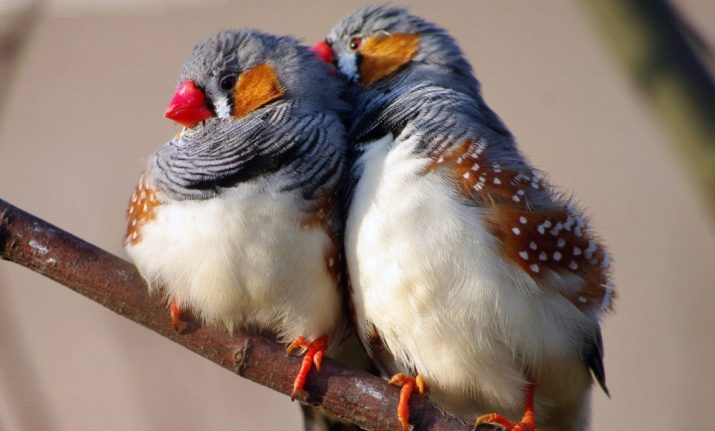
A couple of Amadins will gladly give you offspring if you create the necessary conditions for nesting. To do this, it is worth hanging a special nesting house in a cage, the typical dimensions of which are 20x12 centimeters. In itself, it is not a nest yet - future parents must themselves build a dwelling on the basis of it from twigs of willow, hay and so on. Give them the opportunity to realize their instincts: provide access to feathers, chopped old washcloths, sawdust and dry grass.
Beware of giving cotton wool - it is not suitable for building a nest and is even dangerous for weavers. When all conditions for reproduction are provided, provide one more, irreplaceable - complete silence and calm.
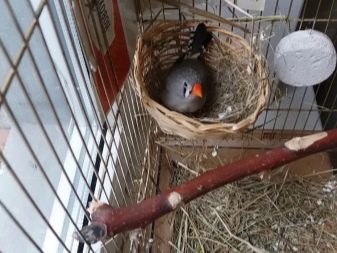

The size of the masonry in the female amadina is 2-6 small testicles that alternately hatch by both representatives of the pair. The hatching periods are very short - approximately two weeks after laying the eggs, small and completely naked chicks will already appear.
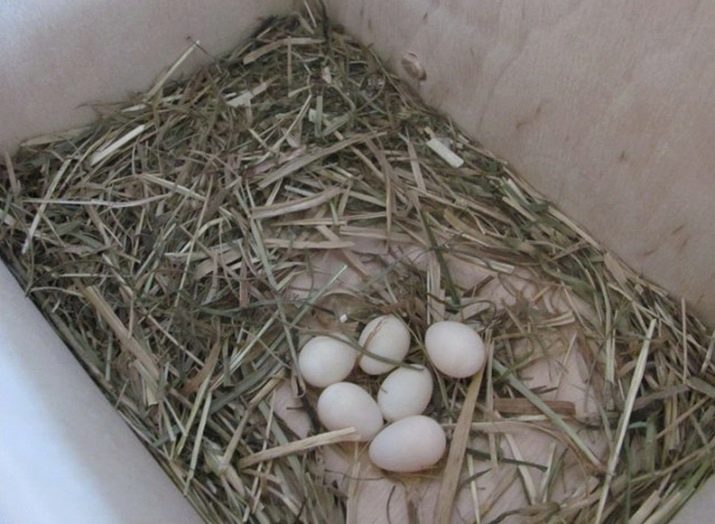
The extreme simplicity of cultivating amadins is also that the hosts take no action to care for the chicks. Their task is simply to provide adult birds with a sufficient amount of varied food and water, as well as guarantee peace and quiet, while all the main concerns fall entirely on the shoulders of the feathered parents.
Kids grow as fast as they hatch, being eggs - three weeks after hatching, young growth begins to leave the nest more confidently, and soon adult birds stop feeding it. At this moment, young people can be considered adults - they can be separated from their parents and even given to their own acquaintances.
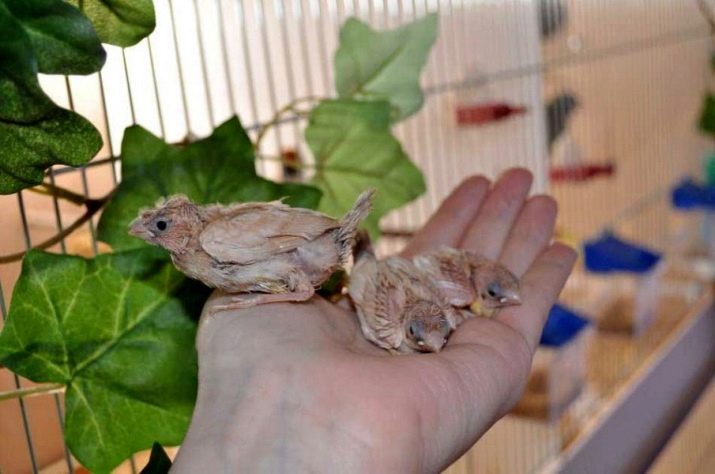
Possible content difficulties
Amadin is described as friendly and rather shy birds, but it happens that the pichuga bites the owner’s hand, although it did not show hostility to it before. There may be many reasons for this behavior - consider all of them.
- If the cage is set above eye level, the bird, no matter how strange it sounds, feels its superiority over man and allows himself to attack him. This is one of the few situations that can be easily fixed - you just need to outweigh the cell somewhere below.
- Aggression of a pet can be caused by a stress or a fright experienced by it - having driven into its head that its life is in danger, the amadina will perceive any creeps in her address as an attack. If you inadvertently scared the pichugs out of place, they will not calm down soon - it will take about two weeks for them to return to their normal state. During all this time, pets should be disturbed to a minimum - even cleaning will have to be postponed until later.
- Pecking of the hand is often found in young animals - this is nothing more than curiosity and an attempt to know the world around us. It is curious that the cry of a person from surprise and pain can be perceived by the bird as an encouragement, because the bites will continue and will become more painful. If you don’t stop reacting like that at the initial stage, over time the amadina will develop a habit, and then you will not redo it. In addition, sometimes the baby just tries to climb the “strange branch”, and you, pulling out your hand, only provoke the bird to act more quickly.
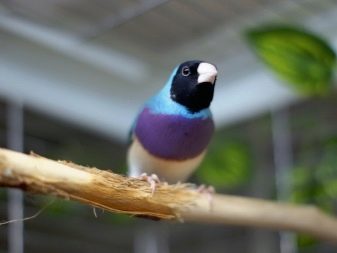

Another common problem is that birds fight and pluck feathers from each other. Under normal conditions, they do not behave this way, which means that their aggression was provoked by a lack of something, for example, free space, lighting, access to the same bathing facilities. Any shortcomings of content, including with heat or dry air, lead to fights. Noticed that a large number of calories or soft foods that do not require effort to absorb, help the Amadins accumulate aggression.
In addition, hostility can arise between representatives of different species, representatives of the same sex, competing for the attention of the opposite sex (especially if it is not at all) and birds of very different ages. The attacked bird usually hisses at the offenders. It happens that Amadins are aggressive for no apparent reason - then the matter lies in the psyche, and the individual must be isolated.
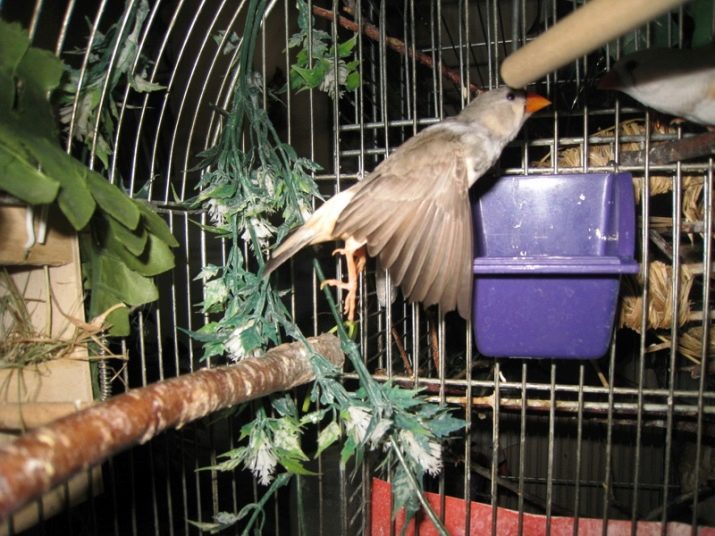
If you see that the female is pecking the male, then he is trying to care for her, and she is not yet ready for reproduction. When the couple has already laid eggs, this behavior (in either direction) means that the partner is not fulfilling his parental responsibilities, and they are trying to force him into the nest.
Comparison with other birds
Compared to most other poultry, such as a canary, a cockatiel, a budgie, an amadina rightly seems less whimsical: all it needs is timely, but rather rare feeding and maintaining the right temperature and humidity. A certain difficulty in caring for it may be cleaning during the molting period - feathers fall out and can fly around the apartment if not collected.
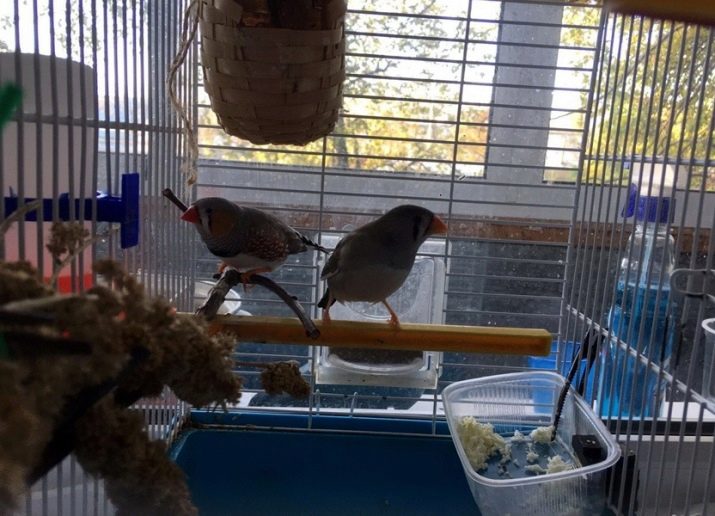
At the same time, the insanely active amadina, unlike all other birds, is not recommended to be released from the cage, even if the room is tightly closed. The fact is that this swift and shy bird will do everything to prevent you from catching it again, and on its way it can meet sudden noises and other frightening factors that will lead the bird to panic and cause it to rush about, risking injury.
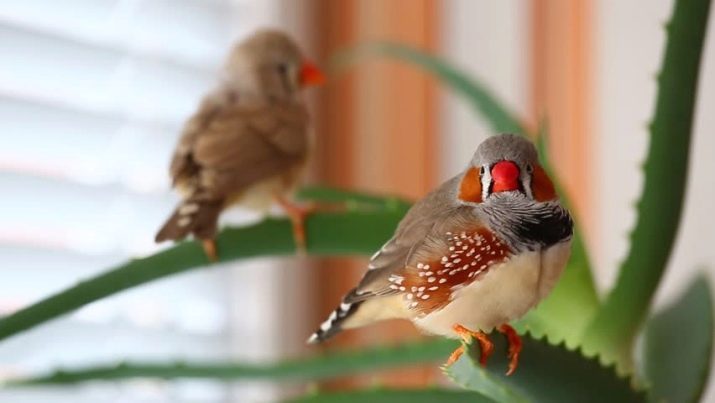
Review Reviews
Owners in most cases respond positively to the content of amadins at home - it is not for nothing that this bird has conquered all pet stores. They are extremely simple to care for, and the possible difficulties that were described above are relatively rare and not relevant if your cage contains only one bird, even though solitary content is not too good for a pet.
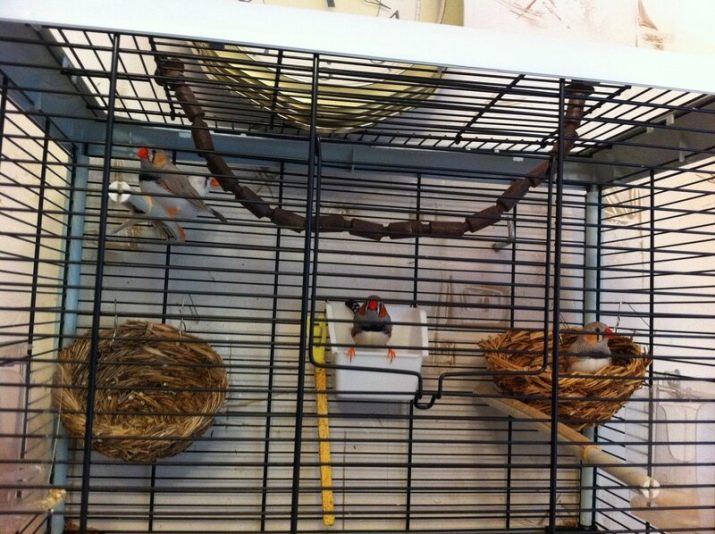
If in life you see yourself as a poultry house, such a pet will be good already in that it will allow you to get your first offspring at home without any extra effort.
See how to keep and care for your homemade amadines in the next video.
